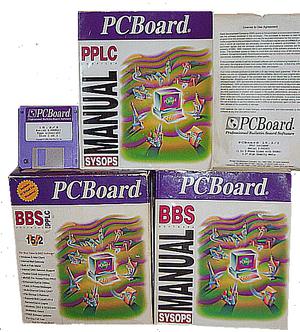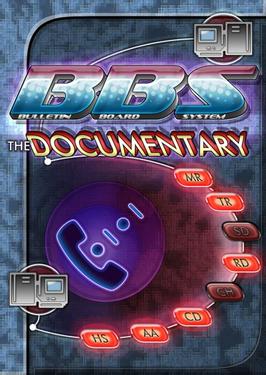
A bulletin board system (BBS), also called a computer bulletin board service (CBBS), was a computer server running software that allowed users to connect to the system using a terminal program. Once logged in, the user could perform functions such as uploading and downloading software and data, reading news and bulletins, and exchanging messages with other users through public message boards and sometimes via direct chatting. In the early 1980s, message networks such as FidoNet were developed to provide services such as NetMail, which is similar to internet-based email.
FidoNet is a worldwide computer network that is used for communication between bulletin board systems (BBSes). It uses a store-and-forward system to exchange private (email) and public (forum) messages between the BBSes in the network, as well as other files and protocols in some cases.

Peer-to-peer (P2P) computing or networking is a distributed application architecture that partitions tasks or workloads between peers. Peers are equally privileged, equipotent participants in the network, forming a peer-to-peer network of nodes. In addition, a personal area network (PAN) is also in nature a type of decentralized peer-to-peer network typically between two devices.
Phreaking is a slang term coined to describe the activity of a culture of people who study, experiment with, or explore telecommunication systems, such as equipment and systems connected to public telephone networks. The term phreak is a sensational spelling of the word freak with the ph- from phone, and may also refer to the use of various audio frequencies to manipulate a phone system. Phreak, phreaker, or phone phreak are names used for and by individuals who participate in phreaking.
The computer art scene, or simply artscene, is the community interested and active in the creation of computer-based artwork.
Routing in the PSTN is the process of forwarding telephone calls between the constituent telephone networks that comprise the public switched telephone network (PSTN).

Thomas Daniel Jennings is a Los Angeles-based artist and computer programmer, known for his work that led to FidoNet, and for his work at Phoenix Software on MS-DOS integration and interoperability.
WWIV was a brand of bulletin board system software popular from the late 1980s through the mid-1990s. The modifiable source code allowed a sysop to customize the main BBS program for their particular needs and aesthetics. WWIV also allowed tens of thousands of BBSes to link together, forming a worldwide proprietary computer network, the WWIVnet, similar to FidoNet.

PCBoard (PCB) was a bulletin board system (BBS) application first introduced for DOS in 1983 by Clark Development Company. Clark Development was founded by Fred Clark. PCBoard was one of the first commercial BBS packages for DOS systems, and was considered one of the "high end" packages during the rapid expansion of BBS systems in the early 1990s. Like many BBS companies, the rise of the Internet starting around 1994 led to serious downturns in fortunes, and Clark Development went bankrupt in 1997. Most PCB sales were of two-line licenses; additional line licenses were also available.

BBS: The Documentary is a 3-disc, 8-episode documentary about the subculture born from the creation of the bulletin board system (BBS) filmed by computer historian Jason Scott of textfiles.com.

FirstClass is a client–server groupware, email, online conferencing, voice and fax services, and bulletin-board system for Windows, macOS, and Linux. FirstClass's primary markets are the higher-education and K-12 education sectors, including four of the top ten largest school districts in the United States.
Canada Remote Systems, or simply CRS, was a major commercial bulletin board system located in the Toronto area. It was one of the earliest commercial systems outside the "big iron" companies such as CompuServe or The Source, and survived into the 1990s before being overwhelmed by the Internet and closing down.
RelayNet was an e-mail exchange network used by PCBoard bulletin board systems (BBS's). By 1990, RelayNet comprised more than 200 bulletin board systems. BBS's on RelayNet communicated via a communications protocol called RIME.
Pagan Occult Distribution System Network (PODSnet) was a neopagan/occult computer network of Pagan Sysops and Sysops carrying Pagan/Magickal/Occult oriented echoes operating on an international basis, with FIDO Nodes in Australia, Canada, Germany, the U.K., and across the USA. PODSnet grew rapidly, and at its height, was the largest privately distributed network of Pagans, Occultists, and other people of an esoteric bent on this planet.
Celerity BBS was a descendant of the freely distributed source of TCS BBS 1.43, and ultimately nearly completely rewritten.
Pastry is an overlay network and routing network for the implementation of a distributed hash table (DHT) similar to Chord. The key–value pairs are stored in a redundant peer-to-peer network of connected Internet hosts. The protocol is bootstrapped by supplying it with the IP address of a peer already in the network and from then on via the routing table which is dynamically built and repaired. It is claimed that because of its redundant and decentralized nature there is no single point of failure and any single node can leave the network at any time without warning and with little or no chance of data loss. The protocol is also capable of using a routing metric supplied by an outside program, such as ping or traceroute, to determine the best routes to store in its routing table.

RemoteAccess is a DOS Bulletin Board System (BBS) software package written by Andrew Milner and published by his company Wantree Development in Australia. RemoteAccess was written in Turbo Pascal with some Assembly Language routines. RemoteAccess began in 1989 as a clone of QuickBBS by Adam Hudson. It was released under the shareware concept in 1990 and became popular in North America, Europe, UK, South Africa, and the South Pacific. Initially the main advantage over QuickBBS was its ability to run multiple nodes under Microsoft Windows, Quarterdeck's DESQview and OS/2. RA could also operate over a network or even a combination of network and multitasking operating systems to provide multiple "nodes per station" capabilities.

textfiles.com is a website dedicated to preserving the digital documents that contain the history of the bulletin board system (BBS) world and various subcultures, and thus providing "a glimpse into the history of writers and artists bound by the 128 characters that the American Standard Code for Information Interchange (ASCII) allowed them". The site categorizes and stores thousands of text files, primarily from the 1980s, but also contains some older files and some that were created well into the 1990s. A broad range of topics is presented, including anarchy, art, carding, computers, drugs, ezines, freemasonry, computer games, hacking, phreaking, politics, computer piracy, sex, and UFOs. The site was created and is run by Jason Scott.
ZOOiD BBS was a Toronto area Bulletin board system in 1986 - 1993 that served a creative community. The sysop was David H. Mason, assisted by several others. Among its members was Rasmus Lerdorf.
FrontDoor was one of the most popular mailers in the FidoNet-compatible networks in the 1990s, acting as the physical representation of the written network node connection and mail handling standards. It was an MS-DOS-based product written by Joaquim Homrighausen. The FrontDoor system contained a Mailer, an Editor, a Terminal, a serial port device driver and configuration utilities. FrontDoor was first released in 1986.







